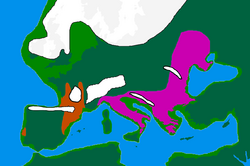History:Last Glacial Maximum refugia
Last Glacial Maximum refugia were places (refugia) in which humans and other species survived during the Last Glacial Period in the Northern Hemisphere, around 25,000 to 20,000 years ago.[1]
Sub-Saharan Africa and Australia were not affected by the glaciation, although vast areas of those continents were too dry for human habitation of any sort, even by the most specialised and well-adapted foragers. New Zealand had no humans at the time. Some recent archaeological evidence suggests the possibility that human arrival in the Americas may have occurred prior to the Last Glacial Maximum more than 20,000 years ago, including possibly areas adjacent to ice sheets, but research is still in an early stage. The best attested shelters are therefore mainly those in Eurasia. Several of them have been studied.
Europe
- Solutrean
- Gravettian
- Pavlovian culture
- Franco-Cantabrian region
- Würm glaciation
North Africa
- Ibero-Maurusian
- Capsian culture
Asia
- Kebaran culture
- Japan, Jōmon period
See also
- Glacial relict
- Magdalenian
- Upper Paleolithic
- Eurasiatic languages
References
- ↑ Hampe, Arndt; Rodríguez-Sánchez, Francisco; Dobrowski, Solomon; Hu, Feng Sheng; Gavin, Daniel G. (2013). "Climate refugia: from the Last Glacial Maximum to the twenty-first century". The New Phytologist 197 (1): 16–18. ISSN 0028-646X. https://www.jstor.org/stable/newphytologist.197.1.16.
fi:Viime jääkauden huippukauden refugio
 |


